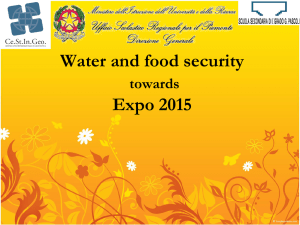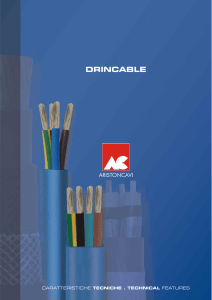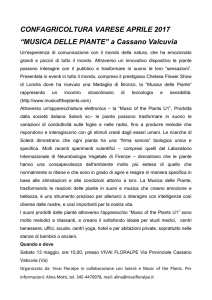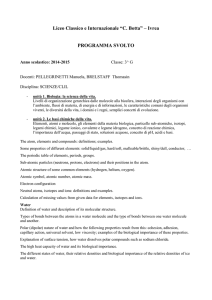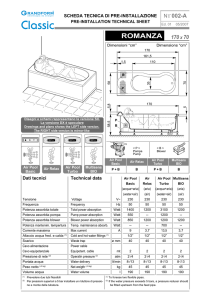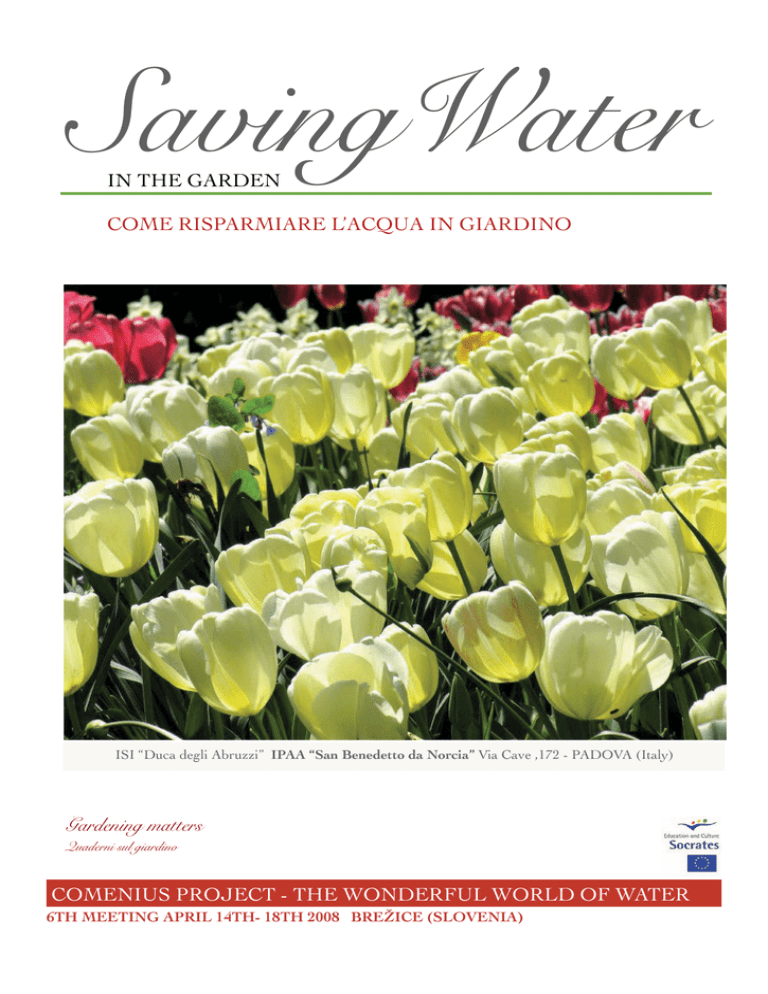
SavingWater
IN THE GARDEN
COME RISPARMIARE L’ACQUA IN GIARDINO
ISI “Duca degli Abruzzi” IPAA “San Benedetto da Norcia” Via Cave ,172 - PADOVA (Italy)
Gardening matters
Quaderni sul giardino
COMENIUS PROJECT - THE WONDERFUL WORLD OF WATER
6TH MEETING APRIL 14TH- 18TH 2008 BREŽICE (SLOVENIA)
SOME NUMBERS TO THINK OVER - QUALCHE DATO PER RIFLETTERE
Some numbers
Qualche dato
• Half of the world's population still
suffers with water services inferior to
those available to the ancient Greeks and
Romans.
Metà della popolazione mondiale soffre
per la mancanza d’acqua e dispone di
servizi idrici inferiori a quelli degli antichi
greci o romani.
• Per capita residential use rates in North
America (about 350 litres per person per
day) and Europe (about 200 litres per
person per day) are high compared to
countries in sub-Saharan Africa, where it
is 10 to 20 litres per person per day.
• I consumi idrici del Nord America (circa
350 litri per persona per giorno) e
dell’Europa (circa 200 litri per persona e
per giorno) sono enormi in confronto a
quelli dell’Africa Sub-Sahariana che si
aggirano intorno ai 10 - 20 litri per
persona per giorno.
• Per capita residential use rates in Italy
are about 250 litres per person per day.
The table below provides a general
picture of different drinking water uses in
Italy.
HOW CAN GARDENERS SAVE
WATER?
COME POSSIAMO RISPARMIARE
L’ACQUA IN GIARDINO ?
Keep count of every drop of water Tieni conto di ogni goccia
The huge garden demand of water is hard to d’acqua
sustain in a drought.
So, during peak summer periods, a lot of
municipalities have introduced hosepipe
bans.
Although irksome to gardeners, hosepipe
bans help reduce water demand and help
prevent the introduction of more stringent
measures.
Even without using a hosepipe, it is still
possible to have a beautiful garden.
Discover why plants actually need water and
the plants that aren’t too demanding. Find out
how to create an attractive garden without
draining mains water supplies in hot weather.
La domanda di acqua per il giardino è difficile
da sostenere durante i periodi siccitosi. Così,
molti Comuni hanno introdotto divieti di
annaffiare il giardino durante l’estate.
Sebbene queste misure siano sgradite,
aiutano a ridurre la domanda d’acqua ed
evitano l’introduzione di misure più drastiche.
Anche senza troppa acqua è possibile avere
un bel giardino.
Scopri perché le piante hanno bisogno
d’acqua e quali sono quelle che non ne
richiedono troppa. Impara a creare un bel
giardino senza usare molta acqua in estate.
I giardinieri dovrebbero annaffiare le
Gardeners should water plants when they piante solo quando esse lo richiedono e in
need and in ways that make every
modi tali da salvaguardare ogni goccia
drop of water counts.
d’acqua.
2
• Il consumo di acqua in Italia ammonta a
circa 250 litri per persona per giorno. La
tabella riporta i differenti usi dell’acqua
potabile in Italia.
Why do plants need water?
Perchè le piante hanno bisogno
d’acqua?
Plants depend on
water because most
of them consist of 90
% water, and their
roots have to
maintain this level
during hot spells.
On a single sunny
day, about 2 litres of
water are lost from
every square metre of
vegetation – whether
grass, shrubs or even
vegetables.
In dry periods water
has to come from
reserves in the soil or
from watering by a
gardener.
Water is also used for
plants growth.
In a sun-powered
process called
photosynthesis, water
is combined with
CO2 from the air to
make sugars.
The CO2 gas
enters
leaves
through the stomata
that need to remain
open in the day to
allow photosynthesis
process. This also
allows water to
evaporate freely.
So, as water becomes
scarce, the stomata
close, the
photosynthesis and
the growth slow
down.
If the roots can’t take
up enough water,
plants will wilt, lose
their foliage and
finally die.
The soil water
reserves are usually
drawn upon
by
them up.
Plants are robust and
have developed
techniques for
surviving periods of
drought.
For example, grass
has dormant buds
that remain alive
even when a lawn
has gone brown.
These quickly start to
grow again once the
autumn rains arrive.
Most lawns can be
left unwatered
without causing
long-term
damage.
Many plants
can be left to
find water their
own.
Scrivi per inserire testo An excessive
amount of water
simply drains out of
reach of the roots. On
the other hand,
insufficient water
sprinkled on the soil
merely wets the
surface.
plants
from
May
onwards,
and by late
summer they
will have used
Le piante dipendono
dall’acqua perchè questa
costituisce il 90% dei loro
tessuti e le loro radici devono
mantenere questo livello
durante i periodi caldi. In una
giornata calda, ogni metro
quadro di vegetazione
consuma circa 2 litri d’acqua.
Nei periodi secchi, l’acqua
viene dalle riserve nel suolo.
L’acqua è anche utilizzata per
la crescita.
In un processo alimentato
dall’energia solare, detto
fotosintesi, l’acqua è
combinata con la
CO2 proveniente dall’aria per
produrre zuccheri. La CO2
entra nella foglia attraverso gli
stomi che debbono rimanere
aperti permettendo all’acqua
di evaporare liberamente.
Così, quando l’acqua diviene
scarsa, fotosintesi e crescita
rallentano.
Se le radici non assorbono
abbastanza acqua, la pianta
appassisce, perde le foglie e
poi muore.
3
WHY DO PLANTS NEED WATER? - PERCHÈ LE PIANTE HANNO BISOGNO D’ACQUA?
Le riserve idriche del suolo sono generalmente utilizzate dalle piante da Maggio in avanti e
alla fine dell’estate sono esaurite.
Le piante sono robuste e hanno sviluppato delle tecniche per sopravvivere alla siccità. Per
esempio, le erbe hanno gemme dormienti che rimangono vive anche quando il prato è
diventato secco. Queste si riprendono rapidamente alle prime piogge.
La maggior parte dei prati può sopravvivere senza essere irrigato.
Molte piante possono trovare l’acqua da sole.
Una quantità di acqua eccessiva finisce fuori dalla portata delle radici e d’altra parte una
quantità insufficiente serve solo ad inumidire il suolo superficialmente.
4
WHY DO PLANTS NEED WATER? - PERCHÈ LE PIANTE HANNO BISOGNO D’ACQUA?
In Veneto region
1052 mm of rain
has fallen each
years on average in
the period from
1982 and 2004
( according with
ARPAV dates). The
decreasing rate of
annual rainfall in
the region is about
34 mm per decade
and the summers
can become hotter
and drier. In Padua
the rainfall is 846
mm per year on
average. Gardeners
can play their part in
conserving water
resources.
Storing rainwater in
containers and soil
If you have five
medium containers
of bedding plants
for example, you
might have to give
each of them two
litres of water every
day during the 18
weeks from May to
September. This
amounts 1260 litres
of water. A year’s
worth of rain falling
on a shed (2m x 3m)
could supply this.
Even in the summer
months there is the
potential to gather
1000 litres. Help
the soil to store
water by digging in
or mulching with
organic matter, such
as well-rotted
manure. Deeply
digging beds or
using raised beds
will increase the
volume of soil from
which plants can
take moisture.
Using grey water
Plants can be
watered with bath,
shower, kitchen and
washing machine
water (but not
dishwasher water),
which is collectively
referred to as ‘grey’
water. Grey water
varies in quality and
usually contains
some degree of
contamination.
However, soil and
potting compost is
effective at filtering
out contaminants,
including soaps and
detergents. There
should be no
problem with the
small-scale, shortterm use of grey
water to tide plants
over during a
summer drought.
Nel periodo tra il
1982 ed il 2004
sulla Regione
Veneto sono caduti
in media 1052 mm
di pioggia all’anno
(dati ARPAV).Il
decremento annuo
delle precipitazioni
nella regione è di
circa 34 mm per
decennio e le estati
possono diventare
5
WHY DO PLANTS NEED WATER? - PERCHÈ LE PIANTE HANNO BISOGNO D’ACQUA?
più calde e asciutte.
A Padova le
precipitazioni medie
sono di 846 mm
annui. I giardinieri
possono fare la loro
parte nel conservare
le risorse idriche.
Raccogliendo acqua
piovana in contenitori e
nel suolo
Per irrigare cinque
vasi medi di piante
annuali, per
esempio, sono
necessari circa due
litri ciascuno per
ogni giorno per 18
6
settimane da
Maggio a
Settembre. Il totale
corrisponde a 1260
litri di acqua. La
quantità di pioggia
che cade
annualmente su una
tettoia, se raccolta,
potrebbe fornirli.
Anche nei soli mesi
estivi possono
essere raccolti 1000
litri d’acqua. Il
suolo può essere
aiutato ad
immagazzinare
acqua con la
vangatura e
pacciamandolo con
sostanza organica.
Le aiuole lavorate in
profondità e rialzate
accrescono il
volume di suolo da
cui le piante
possono ricavare
acqua.
Usando le acque bianche
Le piante possono
essere irrigate con
l’acqua del bagno o
della doccia e della
lavatrice (ma non
con quella della
lavastoviglie). Le
acque bianche
variano in qualità e
contengono degli
inquinanti come il
sapone e i
detergenti. Tuttavia
il suolo e il compost
dei vasi sono
efficienti nel filtrare
e depurare l’acqua
dagli inquinanti.
Non ci saranno
quindi problemi ad
usare le acque
bianche in piccola
scala e per brevi
periodi durante i
periodi di siccità.
WHY DO PLANTS NEED WATER? - PERCHÈ LE PIANTE HANNO BISOGNO D’ACQUA?
Different ways to water
The table below shows the advantages and disadvantages of different methods
Sprinklers
Hosepipes
Irrigation systems
Watering cans
These are used to
water lawns to
maintain the moisture
levels of large areas
The large droplets
can damage the soil
surface and the water
just runs away from
plants. You can solve
the problem attaching
a lance or spray head.
Leaving hoses
trickling beside
plants is a mistake,as
the excess of water
drains away, unless
you have plants with
deep roots.
Seep and drip hoses
allow water to sink
slowly into the soil.
In order to save water
they should only left
on long enough to
wet the top 30 cm of
soil. On sandy and
gravely soils nozzles
can aid dispersion.
With a rose on there
is less soil damage
and run off, than
using hosepipe. The
effectiveness of
watering is increased
by ponding
Diversi modi di irrigare
La tabella mostra vantaggi e svantaggi di differenti metodi di irrigazione
Irrigatori a spruzzo
Si usano per mantenere
un elevato livello di
umidità su larghe aree di
prato.
Canne da
irrigazione
Impianti di
irrigazione
Il getto d’acqua può
danneggiare la
superficie del suolo e
l’acqua scorrere
facilmente lontano
dalle piante. I problemi
sono parzialmente
risolti aggiungendo una
lancia e un
frangispruzzo. Lasciare
scorrere l’acqua vicino
ad una pianta è un
errore perchè l’eccesso
si perde in profondità, a
meno che questa non
abbia radici profonde.
Tubi filtranti e
g o c c i o l a n t i
permettono all’acqua
di penetrare nel
suolo. Non devono
essere lasciati più del
tempo necessario a
inumidire i primi 30
cm di terreno.
Annaffiatoi
Se dotato di rosa,
l’annaffiatoio
danneggia meno il
terreno della canna e
la perdita d’acqua è
minore. L’efficacia
dell’irrigazione è
migliore se le piante
sono coltivate in
trincea o protette da
arginelli di terra.
7
WHY DO PLANTS NEED WATER? - PERCHÈ LE PIANTE HANNO BISOGNO D’ACQUA?
When to water?
When do plants need water?
IT DEPENDS ON SOIL NATURE AND KIND OF PLANTS
Clay soils
They keep water, but the water is not fully
Remember
The quality and quantity of vegetables is improved by
available for the plant roots so they feels slightly
watering when drought would affect the part of plant that is
damp when all the available water has been used.
harvested. Containers need frequent watering because they
Sandy soil
They didn’t keep water but they are dry to the
touch even when some water is available.
only hold a limited amount of water. You can observe the
surface of the compost. Some compost doesn’t keep enough
water so you can’t ever tell if you have given a pot enough
water when the excess flows out of the bottom. In any case
a saucer will retain this run off and the plant can absorb it.
Quando irrigare?
Quando le piante hanno bisogno d’acqua?
DIPENDE DALLA NATURA DEL SUOLO E DALLA SPECIE VEGETALE
Suoli argillosi
Trattengono l’acqua, ma questa non è pienamente
Ricorda
La qualità e quantità di ortaggi è migliorata dall’irrigazione
disponibile per le piante. Possono risultare
quando la siccità può colpire le parti della pianta da
leggermente umidi anche se non contengono
raccogliere. I vasi hanno bisogno di frequenti irrigazioni
abbastanza acqua utilizzabile.
perché possono contenere una limitata quantità d’acqua. Si
Suoli sabbiosi
Non trattengono l’acqua e possono risultare
asciutti al tocco anche se vi è ancora acqua
disponibile.
8
deve osservare la superficie del substrato tenendo presente
che non sempre trattiene l’acqua. Il fuoriuscire dell’acqua
dal fondo del vaso non sempre indica una sufficiente
irrigazione. Un sottovaso può raccogliere l’acqua che la
pianta può assorbire successivamente.
HOW MUCH WATER? - QUANTA ACQUA?
Watering frequency
The table below suggests the watering frequency for different plants
WATER WHEN THE SOIL IS DRY
•Perfect lawn
•Leafy salads; peas and beans in
flower
•New planting
•Containers and hanging basket
•Borders next to high walls
WATER EVERY 7-10 DAYS IN DRY
PERIODS*
•Plants in drought-prone sandy
soils or sticky clays
WATER SELDOM NEDEED
•Drought-tolerant plants
•Most lawn, established trees
•Most vegetables and fruit
•Bedding plants
and shrubs
•Large fruit trees, carrots and
herbs
✴More water in case of high
temperature
•Established perennials on
deep, sandy loam or clay-loam
soil
Frequenza di irrigazione
La tabella suggerisce la frequenza di irrigazione in situazioni diverse
IRRIGARE QUANDO IL SUOLO È
ASCIUTTO
•Tappeto erboso
•Insalate ; piselli e fagioli in
fiore
•Le piante appena messe a
dimora
•Vasi e cestini appesi
•Le bordure vicine ai muri
IRRIGARE OGNI 7-10 GIORNI*
•Piante in suoli facile al
disseccamento
•La maggioranza delle verdure
e delle piante da frutto
•Le piante da frutto
✴Le irrigazioni possono essere
IRRIGARE SOLO AL BISOGNO
•Piante tolleranti la siccità
•La maggior parte dei prati,
degli alberi e degli arbusti ben
insediati
•Grandi alberi da frutto, carote
ed erbe aromatiche
più frequenti in caso di
•Perenni insediati in suoli
temperature molto elevate
organici
9
HOW TO SAVE WATER? - COME RISPARMIARE ACQUA?
How to save water?
Reducing the amount of water needed to keep a garden green and growing is surprisingly easy.
Here are some simple ideas for family gardens and container display
CHECKLIST
Prepare soil in autumn and winter to minimize
moisture loss
Install water butts to collect rain
Mulch in late winter
Recycle kitchen water
Grow drought-tolerant plants
Put saucers under containers
Limit the number of hanging baskets
Avoid watering lawns
Remove weeds – they use water too
If possible, plant in spring or autumn
Most of us think about making our gardens look
beautiful, but how many of us ensure it does not
need much watering?
With just a bit of thought, it’s possible to reduce the
amount of water needed to keep plants growing and
to minimise the labour involved in applying water.
To begin with, it is important to understand your
garden. Does it have free-draining soil that rapidly
dries out in summer? If the answer is yes, then it is
worth planting drought-tolerant plants to begin
with. Of course, you may still want to grow a few
thirsty plants, so it is best to use water-saving
features and techniques too.
The individual ideas can be used in any garden, but
they really help to save water when they are
combined.
Bergenia is a drought
resistant plant because of
the rhizomes
I rizomi della Bergenia
resistono ai periodi
secchi
10
HOW TO SAVE WATER? - COME RISPARMIARE ACQUA?
Come risparmiare l’acqua?
Ridurre della quantità d’acqua necessaria a mantenere un giardino in buone condizioni vegetative è
facile. Qui ci sono alcune semplici idee per giardini familiari e in vaso.
CHECKLIST
Preparare il suolo in autunno e in inverno per
limitare la perdita di umidità
Installare cisterne per raccogliere l’acqua di
pioggia
Effettuare una pacciamatura nel tardo inverno
Coltivare piante tolleranti la siccità
Posizionare un piattino di raccolta sotto i vasi
Limitare il numero di vasi appesi
Evitare di innaffiare il prato
Eliminare le malerbe poiché consumano acqua
Se possibile piantare in primavera e in
autunno
Molti di noi si preoccupano di rendere bello il
proprio giardino, ma quanti di noi si curano di
quanta acqua è necessaria?
Con qualche accorgimento è possibile ridurre la
quantità d’acqua consumata dalle piante e
minimizzare il lavoro necessario per irrigare.
Prima di tutto è importante sapere se il tuo
il tuo giardino ha un suolo drenante che
rapidamente si secca in estate.
Se la risposta è si, vale la pena di piantare piante
resistenti alla siccità.
Naturalmente si possono anche coltivare alcune
piante più esigenti, però è bene usare tecniche di
risparmio dell’acqua.
I singoli suggerimenti possono essere usati in
ogni giardino, ma essi permettono realmente di
risparmiare acqua quando sono combinati.
Sedum stores water in the
thick, fleshy leaves
Il Sedum immagazzina
acqua nelle foglie carnose
11
HOW TO SAVE WATER? - COME RISPARMIARE ACQUA?
Containers display
DISPOSIZIONE DEI CONTENITORI
To reduce the water needed by containers,
try grouping them together. This allows the
plants to shade each other and, as a result,
less moisture will be lost from their leaves.
Also place a saucer under each pot to collect
water that would otherwise run away. This
reservoir will be absorbed by the plants.
If you have a choice, position your
containers in a sheltered spot near the
kitchen so it is easy to use grey water .
As well as watering by hand, containers can
be connected to an automatic irrigation
system.
Set to deliver the minimum amount of water,
it is economical and can water while you are
on holiday.
Per ridurre la necessità d’acqua cerca di
raggruppare le piante. Questo permetterà
loro di ombreggiarsi a vicenda, con il
risultato che sarà persa meno acqua dalle
foglie. Posizionare un sottovaso sotto
ciascun vaso per raccogliere l’acqua che
potrebbe altrimenti andare perduta. Questa
riserva sarà assorbita dalle piante.
Se ne hai la possibilità, posiziona i tuoi vasi
in un posto riparato vicino alla cucina, così
è più semplice usare le acque grigie.
Oltre all’irrigazione manuale, i vasi possono
essere collegati ad un sistema automatico di
irrigazione.
Stabilire la minima quantità d’acqua, è
economico e puoi irrigare mentre sei in
vacanza.
To reduce the water
needed by containers, try
grouping them together.
Per ridurre la necessità
d’acqua cerca di
raggruppare le piante.
12
HOW TO SAVE WATER? - COME RISPARMIARE ACQUA?
Family-size gardens
I GIARDINI FAMILIARI
To keep the task of watering to a minimum,
mulch the surface of the soil in late winter. This
will help to keep as much water in the ground as
possible during dry weather. Thankfully, mature
trees and shrubs do not need watering. Likewise
a lawn can be left to brown, although small
areas are worth watering to help the surface
resist the heavy wear of children playing.
Water butts are invaluable. They can store runoff from the roofs of houses, greenhouses and
sheds, fit neatly against walls and can be placed
near vegetable beds to make watering easy.
When the butts are running low, save the water
for edibles such as vegetables and herbs.
Other thirsty plants such as bedding can be
watered with grey water. After prolonged spells
without rain, it is prudent to discard the first
bucketful of water, as this may contain dust and
other pollutants from the roof.
Per raggiungere lo scopo di irrigare al minimo, è
utile coprire la superficie del suolo nel tardo
inverno. Questo permetterà di mantenere il più
possibile l’acqua nel suolo durante la stagione
asciutta.
Fortunatamente, alberi adulti e arbusti non
necessitano di irrigazione. Ugualmente un prato
può essere lasciato imbrunire, anche se vale la pena
di irrigare piccole aree per aiutare la superficie a
resistere alla forte usura del gioco dei bambini.
I serbatoi per immagazzinare l’acqua sono
insostituibili. Essi possono raccogliere l’acqua di
scorrimento dai tetti delle case, serre e capanni, si
adattano bene contro una parete e possono essere
posizionati vicino alle aiuole di ortaggi per irrigarle
facilmente. Quando il serbatoio si sta esaurendo,
risparmia l’acqua per le piante commestibili, come
ortaggi e aromatiche. Le altre piante da irrigare
come le erbacee da fiore, possono essere irrigate
con acque grigie. Dopo un lungo periodo senza
pioggia, è prudente scartare il primo secchio
d’acqua, poiché questa potrebbe contenere polvere
e altre sostanze inquinanti provenienti dal tetto.
Water butts are invaluable.
I serbatoi per immagazzinare
l’acqua sono insostituibili
13
A drought resistant plants selection
Una selezione di piante resistenti alla siccità
Trees (small - medium)
Alberi (mediopiccoli)
Acer negundo
Betula (B. papyrifera; B. pendula
Celtis (C. australis; C.
occidentalis)
Cercis siliquastrum
Crataegus (C. laevigata [inc
'Paul's Scarlet']; C. persimilis
'Prunifolia'; C. phaenopyrum)
Genista aetnensis
Gleditschia triacanthos (inc
'Sunburst')
Koelreuteria paniculata
Ligustrum lucidum
Maclura pomifera
Populus tremula
Prunus lusitanica
Robinia pseudoacacia (inc
'Frisia')
Sophora japonica
Shrubs (small - medium)
Arbusti (mediopiccoli)
Artemisia (A. abrotanum; A.
absinthium )
Caryopteris x clandonensis
Ceratostigma willmottianum
Cotoneaster (C. conspicuus
'Decorus' ; C. dammeri , C.
horizontalis )
Euonymus fortunei (inc 'Silver
Queen' )
Genista
Helichrysum (H. italicum H.
thianschanicum)
Hypericum (deciduous and
evergreen)
Lavandula
Lespedeza thunbergii
Lonicera pileata
Mahonia (M. aquifolium; M.
repens)
Nandina domestica
Perovskia (P. atriplicifolia , 'Blue
Spire' )
Potentilla fruticosa
Prunus laurocerasus ('Otto
Luyken' , 'Zabeliana')
Rosa pimpinellifolia
Rosmarinus officinalis Prostratus
Ruscus aculeatus
14
Ruta graveolens 'Jackman's
Blue'
Salvia (inc S. fulgans; S.
involucrata; S. officinalis)
Santolina
Spiraea japonica (inc 'Gold
Flame' )
Symphoricarpus (S. x chenaultii;
S. doorenbosii)
Teucrium (T. x lucidrys; )
Shrubs (medium - large)
Arbusti (mediograndi)
Abelia x grandiflora
Aralia elata
Arbutus unedo
Berberis (deciduous and
evergreen)
Buddleja (B. crispa; B. davidii)
Buxus sempervirens
Callistemon citrinus (inc
'Splendens' )
Ceanothus (deciduous and
evergreen)
Ceratonia siliqua
Choisya ternata
Colutea (C. arborescens; C. x
media)
Cotoneaster (C. glaucophyllus;
C. lacteus
C. salicifolius; C. simonsii
Cytisus scoparius
Elaeagnus (E. angustifolia; E. x
ebbingei ; E. pungens )
Escallonia
Euonymus (E. alatus E.
japonicus )
Genista tenera 'Golden Showers'
Hippophae rhamnoides
Ilex (I. x altaclerensis; I.
aquifolium )
Laurus nobilis
Lavatera thuringiaca
Lespedeza bicolor
Ligustrum japonicum
Photinia (P. x fraeri, inc. 'Red
Robin' Pittosporum tobira
Poncirus trifoliata
Prunus (P. laurocerasus ; P.
lusitanica)
Pyracantha
Rhamnus alaternus (inc
'Argenteovariegata')
Rhus glabra (inc 'Laciniata' )
Rosa (R. rugosa; R. virginia ; R.
wichuriana)
Rosmarinus officinalis
Sambucus (S. nigra; S.
racemosa)
Spartium junceum
Spiraea x billardii
Symphoricarpus (S. albus; S.
orbiculatus)
Tamarix
Viburnum tinus
Vitex agnus-castus
Climbers/wall-trained shrubs
Rampicanti e arbusti da
spalliera
Abutilon (A. megapotamicum )
Campsis
Cotoneaster horizontalis
Euonymus fortunei 'Silver
Queen'
Fallopia baldschuanicum
Fremontodendron (inc
'California Glory' )
Hedera
Hydrangea anomala ssp.
petiolaris
Jasminum
Lonicera japonica (inc
'Halliana' )
Parthenocissus tricuspidata
Passiflora caerulea
Punica granatum
Pyracantha
Rosa banksiae
Vitis vinifera
Wisteria (W. floribunda; W.
sinensis)
Herbaceous perennials
Erbacee perenni
Achillea (A. filipendulina; A.
millefolium
Alchemilla mollis
Centranthus ruber
Cerastium tomentosum
Dianthus (border carnations;
pinks)
Echinops
Erodium
Eryngium
Euphorbia
Geranium (G. endressii; G.
macrorrhizum; G. x oxonianum;
G. x riversleaianum; G.
sanguineum)
Gypsophila paniculata
Heuchera
Linum perenne
Liriope (L. muscari; L. spicata)
Melissa officinalis
Nepeta (N. x faassenii; N.
nervosa; 'Six Hills Giant')
Oenothera (O. fruticosa; O.
macrocarpa )
Sedum (S. spectabile; S.
spurium; S. telephium)
Stachys byzantina
Symphytum (S. ibericum;
'Hidcote Blue')
Tanacetum parthenium
Verbascum
Veronica prostrata
Ornamental grasses
Graminacee ornamentali
Cortaderia selloana
Festuca glauca (inc 'Blaufuchs')
Helictotrichon sempervirens
Panicum virgatum
Pennisetum (P. alopecuroides; P.
setaceum)
Phalaris arundinacea
Pseudosasa japonica
Stipa (S. calamagrostis; S.
gigantea)
Annuals & bedding
Annuali e piante da aiuola
Alcea
Alyssum
Amaranthus
Brachycombe
Calendula
Cosmos
Eschscholzia
Felicia
Gazania
Lunaria annua
Mesembryanthemum
Papaver somniferum
Portulaca
Salvia farinacea
BIBLIOGRAPHY
Bibliografia
ARPAV – CENTRO METEOROLOGICO DI TEOLO Rapporto sugli indicatori ambientali del Veneto, 2002
http://www.arpa.veneto.it/via/regione_veneto/Introduzione.pdf
ARPAV - DIPARTIMENTO REGIONALE PER LA SICUREZZA DEL TERRITORIO
CENTRO METEOROLOGICO DI TEOLO
Evoluzione del clima in Veneto nell’ultimo cinquantennio
www.arpa.veneto.it/home/docs/Evoluzione_del_clima_in_Veneto_cinquantennio_13-09-2007.pdf
ARPAV - DIPARTIMENTO REGIONALE PER LA SICUREZZA DEL TERRITORIO
Rapporto sulla risorsa idrica in Veneto al 30 giugno 2007
http://www.arpa.veneto.it/acqua/docs/interne/Rapporto_risorsa_idrica_Veneto_30-06-2007.pdf
ROYAL HORTICULTURAL SOCIETY Water in the garden
http://www.rhs.org.uk/index.htm
BETH CHATTO Beth Chatto’s Gravel Garden, London, Frances Lincoln, 2000
AUTHORS
Students:
Teachers:
Nicola Penzo
Marianna Ruffato
Massimo Zorzi
Santina Bortolami
Luciano Galliolo
Olga Lo Guercio
Lorenzo Tiso
15
ISI Duca degli Abruzzi - Sezione Professionale San Benedetto da Norcia
Via Cave 172
35100 Padova
ITALY
tel. 0039-049-620274
fax 0039-049-620536
email: [email protected]

